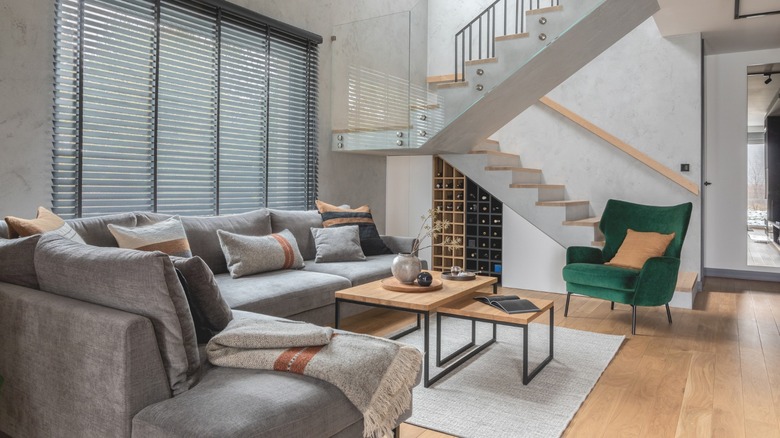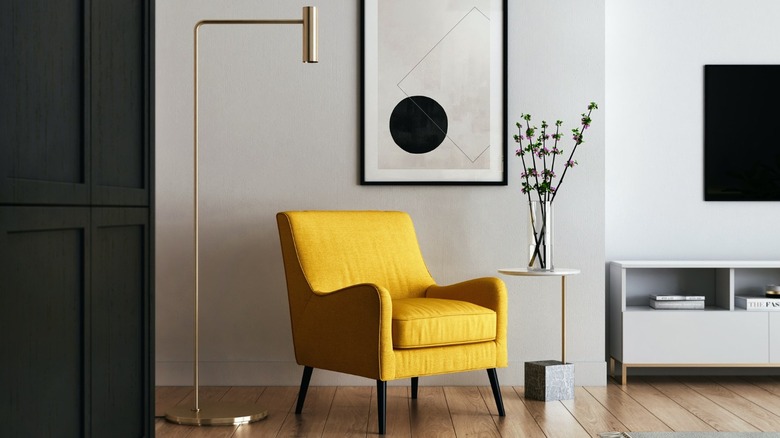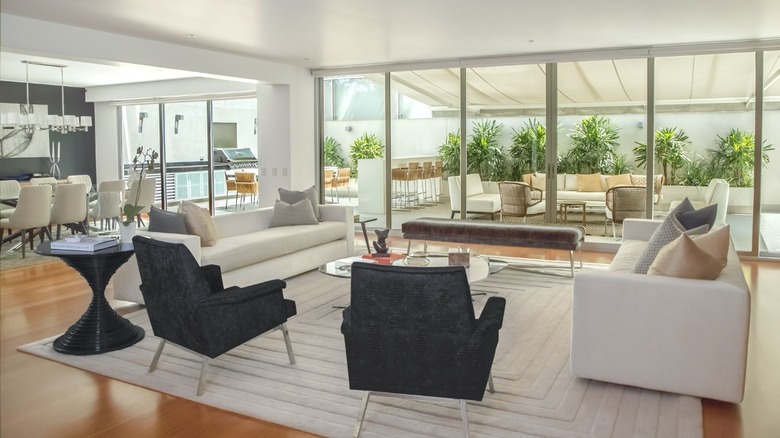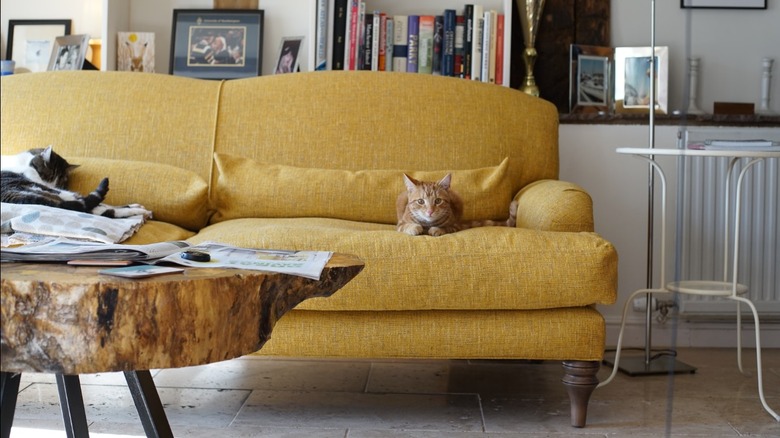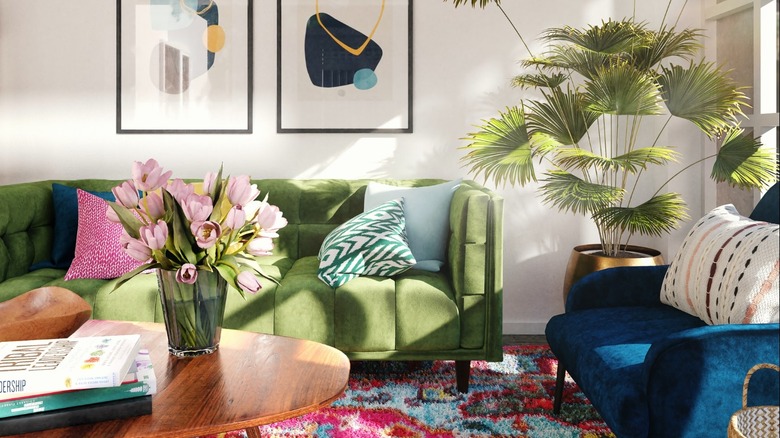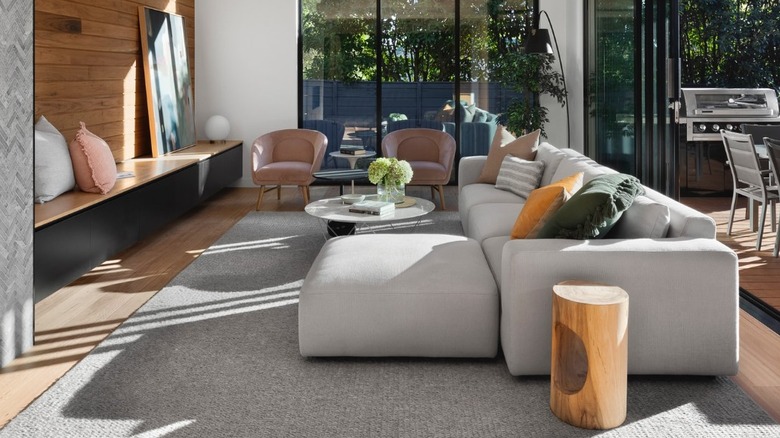The Worst Mistakes You Can Make When Redoing Your Living Room
What state is your living room in? Not geographically, albeit that could affect its condition. Sand, salt water, sun, and humidity levels can wreak havoc on furnishings, fabrics, and finishes (via Ocean Home and Better Housekeeper). Regardless of the region, regular everyday use takes its toll, and if it's been more than a few years since your living room has undergone a major change, it could be time to consider one. Per Elle Decor, a sofa should be replaced after seven to 15 years, and Joaquin Painting suggests new paint every five to seven years. If your living room's lifespan is nearing that, now's a good opportunity to reassess and refresh.
Start gathering inspiration, measurements, and an idea of how much time and money you're willing to invest; making interrelated design decisions and planning for their purchases simultaneously is a logical and ultimately more livable approach. In addition, forethought allows time to sit-test and order furniture, take advantage of sales, and zero in on your style.
There are typical mistakes made by the amateur home decorator that interior designers and experts know to avoid — things that can make a living room feel uncomfortable, unfinished, or uninviting. The Washington Post reported that neglecting to consider the scale and proportion of decor as it relates to its environment is the primary oversight and cause of a space seeming off. Below, we share a list of additional pitfalls and advice on how to keep your design goals on track once you're ready to begin.
Playing it too safe
According to Livingetc, if your living room is not a reflection of your personality, you'll be fatigued by the design before long. That means selecting items that interest you instead of playing it safe by opting for easy pieces. For starters, Olivia Stutz of Olivia Stutz Design recommends allowing a standout sofa to be the foundation of the space and building from there. The room above would be a sleeper without the zesty yellow occasional chair. A chair is an excellent way to speak your language, with so many styles, fabrics, and price points available, yet it's a less frightening commitment than a colorful couch. Shape can make things interesting, too — the swooping arms and high legs would be just as lovely in a neutral cover.
Wall treatments make a remarkable impact, quickly taking a space from average to amazing; paint is the biggest bang for your buck and simple to DIY, while wallpapering may require a professional but creates a custom, high-end impression. Whether you love bright colors and loud patterns or subdued spaces, you can bring in a favorite shade, print, or material in an amount that seems right, from painting the whole room a saturated hue to choosing a bold sofa fabric to adding color with accent pillows or artwork. However, Frances Merrill of Reath Design told Vogue that being afraid to take risks results in each home looking the same as the next — the designer's advice is to go all in.
Going too small with an area rug
An area rug creates definition within a floor plan and offers a way to implement design cohesion throughout the home. (That's particularly important in an open concept plan, where zoning sections into perceived rooms and functions delineates the space.) It's a spectacular avenue for introducing visual softness and pattern and reinforcing the style story or color palette. One can tie elements together, such as furniture textiles, wood tones, and curtain fabrics; additionally, a light carpet can brighten a dark space, per Fusion Furniture.
Yet, the effects of using an area rug in the living room are felt in more than appearance alone. They provide warmth and plushness underfoot and help absorb sound, making the environment more inviting. As a significant part of a room's surface area, the floor treatment demands and deserves a proportionate amount of attention.
Understanding the appeal of an area rug, many homeowners agonize over choosing the ideal specimen, comparing it to paint chips, fabric swatches, and mood boards only to undermine their fastidious planning with a common mistake — selecting a size that is too small. Designer Bobby Berk cautions that an undersized rug can make the design feel out of sync and disallows some of the things rugs do best, like grounding the space and connecting different components, for example. Berk recommends all furniture pieces be partially positioned on the rug to avoid a flimsy or floating effect; this rug guide further explains how to pick the right one.
Choosing appearance over comfort
The way a living room looks is certainly important to most, yet it shouldn't be the top priority. Fine rug purveyor Doris Leslie Blau notes that the room's primary purpose is relaxation, and the stockist cautions against creating surroundings that are too precious to enjoy; fragile materials and light fabrics don't usually accompany a sense of letting go. If your style truly dictates delicate silhouettes and white textiles, do your homework and be prepared to spend a bit more. For example, quality pieces are built to last regardless of heft, and natural or formulated stain-resistant textiles will allow for lighter tones.
The room should be practical and able to stand up to daily use. Ample lighting, functional window treatments that offer privacy and light control, and pleasant flooring are important aspects of a living room design; wool rugs are incredibly durable, naturally anti-allergenic, and odor resistant according to Doris Leslie Blau. Elle Decor notes that a medium-grade rug will last up to 15 years and a high-grade version up to 25.
Cozy and supportive furniture is key to comfort. The sofa is the piece that most defines the space and also where we spend the majority of our time; designers often suggest choosing it before any other components. TLC Interiors explains that it's helpful to narrow a sofa search by starting with the style and function of the room. Is it casual or formal? For entertaining or unwinding? Next, contemplate the size. Lastly, select a comfortable option within those parameters.
Insisting on a matched set
It's easy to fall prey to the idea of the sofa and loveseat suite; the pieces are frequently displayed together in furniture stores and discounted when purchased as a set. On its face, it seems like a great solution — lots of seating, design cohesion, and a good value for your money. Yet The Decorologist explains that the combo package can be limiting. First, the room may accommodate very few arrangements of the two pieces, and second, they don't necessarily offer the seating they appear to — three people rarely want to cozy up together on a loveseat. Furthermore, conversation is tricky when everyone is seated in a row. Finally, unless countered by something else, the L arrangement of a sofa and loveseat pairing will be weighted to one side of the room, relating back to a mistake of balance and proportion.
Instead of a loveseat, a pair of chairs is much more amenable to engaging conversation and flexible furniture placement. They can flank the sofa, facing one another, or sit across from it with a small table in between. Match them exactly to each other or go wild; coordinate them to a sofa pillow fabric or introduce another color or pattern altogether. Alternative pieces are low daybeds and ottomans, which are perfect in front of a fireplace. For large rooms, consider multiple seating areas or a made-to-order sectional, which takes advantage of available space while looking custom and intentional; offer additional seating and interest with occasional chairs.
Being stingy with surfaces
Providing plentiful surfaces in the living room will ensure functionality and a sense of ease, welcoming long periods of lounging. There are abundant cocktail table options, including singular, nesting, or modular bunching tables that can be spread around the room when needed. Stylist and designer Emily Henderson suggests the following guidelines: it should be at least half as long as the sofa, the top should fall within 4 inches of seat height, and there should be no less than 18 inches between the sofa and cocktail table. Side tables are generally positioned at each end of a sofa, while accent and drink tables fill smaller spaces. If the room is an extremely tight squeeze, C tables and armrest tables are excellent options. Further, a console against a wall or the back of a sofa might be ideal.
Tables offer great storage. With shelves, drawers, doors, and tops that open to reveal hidden compartments, miscellaneous items can be stowed away to reduce clutter. Additionally, consider function — would you like wheels for mobility or a top that extends for dining? If there are small children in the household, rounds and ovals (something without sharp corners) are a good choice.
There are myriad styles, price points, and incarnations for living room surfaces; for example, tree stumps, salvaged components, and repurposed pieces; a kitchen table with legs sawed down to appropriate height is a fantastic cocktail table. Being creative with a mix of materials, scale, and finishes will add depth to the design.
